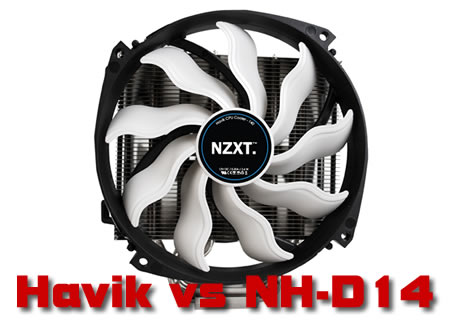NZXT Havik vs Noctua NH-D14 Review
Introduction
There can’t be many readers of OC3D that wont remember the NZXT H2 vs the Fractal R3 face of review we did some time ago. You I’m sure will also remember how badly NZXT reacted to this review. SO badly it has taken us all of this time to finally get a Havik sample out of them, it did cross our minds at one point just to buy one and do the review anyways. But taking on the persistence / borderline harassment leaf out of the hand book from a couple of other websites NZXT finally buckled knowing they had another cooler due out and OC3D’s review wont really mean anything so late………. Shame that.
Anyways its time to have a look at the specifications then get straight on with what will be a rather interesting video review.
Specifications
| MODEL | HAVIK 140 |
| MATERIALS | Aluminum / Copper Nickel-Plated |
| DIMENSIONS | 140(W) x 166(H) x 120(D) mm 135(W) x 160(H) x 60(D) mm (heatsink) |
| WEIGHT | 1035g (including dual 140mm fans) 760g (heatsink) |
| MOUNTING PRESSURE |
55-60 lbs |
| FAN SIZE | Dual 140(W) x 140(H) x 25(D) mm |
| FAN BEARING |
Long Life (Oil-Leaking Prevention) + Shaft with copper sleeve |
| FAN SPEED | 1200 +/- 10% RPM |
| NOISE LEVEL | 25 dBA |
| AIR FLOW | 90.3 CFM |
| CONNECTOR | 3-Pin |
| INPUT POWER | 3.6 W |
| LIFE | 30,000 Hours |
| COMPATIBILITY | Intel Socket:1366, 1155, 1156, 775 CPUs AMD Socket: AM3, AM2+, AM2 CPUs |
Testing
NZXT Havik & Noctua NH-D14
Intel Core-i7 950 @ 4GHz
Gigabyte G1 Assassin
Corsair AX1200W
6GB Mushkin Redline
HIS 6850
Windows 7 Ultimate x64
For the first test we set our i7-950 overclocked to 200×20 @ 1.25v for a clock speed of 4.0GHz. We allow the system to idle for 10 minutes and then run Prime95 ‘maximum heat maximum stress’ setting for a further 30 minutes.
After 30 minutes we note the temperatures of all cores and the ambient temperature of the room. An average of all cores is taken, then the ambient temperature is removed from this figure and this gives us the delta temperature. Delta is the temperature difference above ambient which is a truer reflection of the heat-sink performance rather than mere maximum figures. Testing in an Igloo or the Sahara would give vastly different maximum temperatures, yet the Delta could be the same.
The second test follows all steps from above but with a 200×21 @ 1.35v for 4.2GHz overclock, the extra voltage in this test allows us to see if the heat-sink can cope when extreme loads and overclocks are applied.Â
The last test is at 4.4GHz, 200×22 @ 1.45v and is an extreme test that only extreme coolers will ever pass. Any cooler in this graph is a one of the elite few that has the cooling ability to dissipate the heat created during this grueling test.
Video Review
Conclusion
The introduction to this review is quite a bit more cutting than you are probably used to here at OC3D, but we had to get it out there that we were very annoyed by NZXT’s reaction to what was only ever honesty with the H2 Review.
They stalled for so long and have only just let us have a Havik sample thinking we cant do any damage now, which is a shame really because the only damage we would be doing would be to OTHER manufacturer sales because to put it simply the Havik is awesome.
The mount is a two stage affair and works very well, everything fits tightly together so the screws and the spacers don’t keep falling out all over the place. It all works very well and if you can write your own name you should be able fit this in your rig.
The fan clips are rubber which is a nice touch to stop the fear of one coming loose and shorting out your GPU, but at the same time because they are rubber it would have been nice to have seen one or two spares in the box as I’m sure over time some will break. Also talking about the clips if there isn’t much room above your CPU heat sink at the top of the case, make sure you fit the clips at the top of the case first as you will find it easier to stretch the lower ones into place with a bit of extra room.
Fan wise they do seem noisier than the D14 fans but this is pretty much expected as the Noctua fans are famed for their near silent operation.
So it may have seemed negative up to this point although we are only really pointing out some minor observations but the surprising points start now really. It did always fall behind the D14 in terms of performance but as the voltage and clocks increased the gap narrowed, quite the opposite to what we were expecting. During the 4.4GHz test which is nothing short of the most extreme test we could possibly run with a silicone killing 1.45v coursing through the poor old i7 950 the gap closed to just 0.5c! This is the first single tower cooler to have ever performed this well in our 4.4GHz test.
So to summarise, it’s a single tower cooler that comes with a pair of relatively quiet 140MM fans that shouldn’t effect the main ram slots on most motherboards allowing those of you crazy enough to have massive ram to finally buy a decent air cooler should you need one, and also get near on NH-D14 performance levels.
Its an epic cooler that NZXT really should have sent us sooner, we would go as far to say that this is THE best single tower performance cooler on the market, for those of you stubborn enough to have massive ram and 100% want an air heatsink we honestly think this is the best possible option out there at the moment!Â
Â
We would like to thank NZXT for having the bravery to let us test the Havik finally. Discuss in the forums.Â




